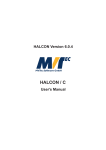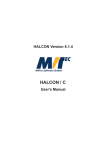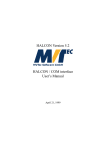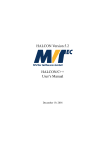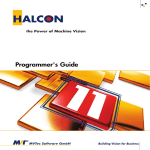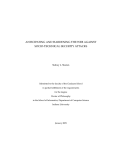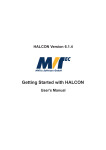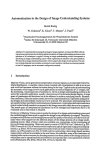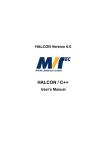Download HALCON Version 5.2 HALCON/C User's Manual
Transcript
HALCON Version 5.2 MVTec Software GmbH HALCON/C User’s Manual 20th April 1999 This manual explains the use of the HALCON/C version 5.2 operators All rights reserved. No part of this publication may be reproduced, stored in a retrieval system, or transmitted, in any form or by any means, electronic, mechanical, photocopying, recording, or otherwise, without prior written permission of the publisher. 1st Edition. 2nd Edition. 3rd Edition. 4th Edition. July 1997 November 1997 March 1998 April 1999 Copyright c 1997-99 MVTec Software GmbH, Munich, Germany MVTec Software GmbH Information concerning HALCON: http://www.mvtec.com Address: MVTec Software GmbH Orleansstr. 34 D-81667 Munich Germany E-mail: [email protected] Contents 1 An introductory example 3 2 HALCON parameter classes 2.1 Image objects . . . . . . 2.2 Control parameters . . . 2.2.1 Simple mode . . 2.2.2 Tuple mode . . . 5 5 6 8 8 . . . . . . . . . . . . . . . . . . . . . . . . . . . . . . . . . . . . . . . . . . . . . . . . . . . . . . . . . . . . . . . . . . . . . . . . . . . . . . . . . . . . . . . . . . . . . . . . . . . . . . . . . . . . . . . . . . . . 3 HALCON operator return values 15 4 Generation of HALCON/C Applications 17 5 Common image processing problems 21 Figures 24 1 2 CONTENTS Chapter 1 An introductory example Before going into the details of HALCON, let’s have a look at a small example. Given the image of a mandrill in Figure 1.1 (left), the goal is to segment its eyes. This is done by the C program shown in Figure 1.2. The segmentation result is shown in Figure 1.1 (right): Figure 1.1: To the left, the image of a mandrill is shown (input image). To the right, the result of the segmentation process in the example program can be seen (eyes). The program is quite self explanatory. We will describe the basic principles nevertheless: First, all image pixels with greyvalues greater than 128 are selected. Then all connected componentes of the region formed by these pixels are calculated. The corresponding HALCON operator calculates a region tuple, and thus splits the image in different regions (objects). From these, the mandrill’s eyes are selected by their area and shape. This little example shows how easy it is to integrate HALCON operators in any C program. Their use is very intuitive: Users don’t have to think about the basic data structures and algorithms involved. And since all HALCON operators are hardware independant, users don’t even have to care about things like different I/O devices. HALCON has its own memory management and provides a sophisticated runtime environment. Have a look at the program in Figure 1.2 again. Isn’t image processing fun this way? But joking aside. In the following chapters we will describe the details of integrating HALCON operators into C programs. Chapter 2 introduces the four different parameter classes of HALCON operators. We will explain the use of HALCON tuples (Chapter 2.2.2) for 3 4 CHAPTER 1. AN INTRODUCTORY EXAMPLE #include "HalconC.h" main() { Hobject mandrill,thresh,conn,area,eyes; /* required objects long WindowHandle; open_window(0,0,512,512,0,"visible","",&WindowHandle); /* open window read_image(&mandrill,"mandrill"); /* read input image ("mandrill") disp_image(mandrill,WindowHandle); /* display input image get_mbutton(WindowHandle,_,_,_); /* wait for mouse click /* Select image region with pixels in [128,255] threshold(mandrill,&thresh,128.0,255.0); connection(thresh,&conn); /* compute connected components /* select regions with an area of at least 500 pixels select_shape(conn,&area,"area","and",500.0,90000.0); /* select the eyes in these regions by using the anisometry feature select_shape(area,&eyes,"anisometry","and",1.0,1.7); disp_region(eyes,WindowHandle); /* display result get_mbutton(WindowHandle,_,_,_); /* wait for mouse click close_window(WindowHandle); /* close window /* delete image objects from the Halcon database clear_obj(mandrill); clear_obj(thresh); clear_obj(conn); clear_obj(area); clear_obj(eyes); } */ */ */ */ */ */ */ */ */ */ */ */ */ Figure 1.2: Introductory example program supplying operators with tuples of control parameters in great detail: Using tuples, the two select shape(...) calls in our example program could be combined into only one call. Chapter 3 is dedicated to the return values of HALCON operators. Chapter 4 gives an overview over all the include-files and C-libraries necessary for compiling C programs and shows a sample makefile. Finally, Chapter 5 contains example solutions for some common problems in image processing (like edge detection). Chapter 2 HALCON parameter classes HALCON distinguishes four different classes of operator parameters: Input image objects Output image objects Input control parameters Output control parameters Input parameters are passed by value, output parameters are passed by reference (using the &operator). An exception to this rule are output control parameters of type char*. Here, the caller has to provide the memory and only a pointer to that memory is passed to the operator. As a rule of thumb, all HALCON operators can also be called using tuples of parameters instead of single values. Take the connection(...) operator from our example program in the previous chapter: It calculates a tuple of output image objects (the connected components). Of course there are several HALCON operators that cannot be called with tuples for some or all parameters. Whether this is the case for specific operators is described in detail in the HALCON reference manual. Unfortunately, C doesn’t provide a generic list constructor (e.g., like the one in PROLOG). Therefore, the use of tuples of control parameters is a little elaborate. Using tuples of image objects on the other hand is in no way different from using single values. HALCON/C provides the data structure Htuple for tuples of control parameters (see Chapter 2.2.2 for details) and the data structure Hobject for image objects (single objects as well as object tuples — see Chapter 2.1). 2.1 Image objects Image processing isn’t possible without actual images. By using image objects, HALCON provides a abstract data model that covers a lot more than simple image arrays. Basically, there are two different types of image objects: Images Regions A region consists of a set of coordinate values in the image plane. Regions need not be connected and may include “holes.” They may even be larger than the image format. Internally, regions are stored by run length encoding. 5 CHAPTER 2. HALCON PARAMETER CLASSES 6 Images consist of at least one image array and a corresponding region. The image region denotes the array pixels that are “defined” (i.e., HALCON operators working on greyvalues will only access pixels in this region). But HALCON supports multi channel images, too: Images may consist of an (almost) arbitrary number of channels. An image coordinate therefore isn’t necessarily represented by a single greyvalue, but by a vector of up to n greyvalues (if the coordinate lies within the image region). This may be visualized as a “stack” of image arrays instead of a single array. RGB- or voxel-images may be represented this way. HALCON provides operators for region transformations (among them a large number of morphological operators) as well as operators for greyvalue transformations. Segmentation operators are the transition from images (greyvalues) to regions. HALCON/C provides the data type Hobject for image objects (both images and regions). In fact, Hobject is a surrogate of the HALCON data base containing all image objects. Input image objects are passed to the HALCON operators by value as usual, output image objects are passed by reference, using the &-operator. Variables of type Hobject may be a single image object as well as tuples of image objects. Single objects are treated as tuples with length one. Of course, users can access specific objects in an object tuple, too. To do so, it is necessary to extract the specific object key (converted to integer) first, using the operators obj to integer(...) or copy obj(...). The number of objects in a tuple can be queried with count obj(...). To convert the keys (returned from obj to integer) back to image objects again, the operator integer to obj(...) has to be used. It may be noted that integer to obj(...) duplicates the image objects (Don’t worry, this doesn’t mean necessarily, that the corresponding greyvalue arrays are duplicated too. As long as there is only readaccess, a duplication of the references is sufficient). Therefore, all extracted objects have to be deleted explicitly from the HALCON data base, using clear obj(...). Figure 2.1 contains an excerpt from a C program to clarify that approach. Some HALCON operators like neighbor(. . . ) or difference(...) allow the use of the following specific image objects as input parameters: NO OBJECTS: An empty tuple of image objects. EMPTY REGION: An image object with empty region (area = 0). FULL REGION: An image object with maximal region. These objects may be returned by HALCON operators, too. 2.2 Control parameters HALCON/C supports the following data types as types for control parameters of HALCON operators: integers, floating point numbers, character arrays (strings) As already mentioned in the introduction to this chapter, using control parameter tuples in C isn’t as elegant as using image object tuples. To circumvent the missing generic lists in C, it was necessary to introduce two different working modes into HALCON/C: The simple mode and the tuple mode. If a tuple is necessary for at least one control parameter, the tuple mode 2.2. CONTROL PARAMETERS ... Hobject Hobject long Htuple Htuple long long objects; obj; surrogate; Tsurrogates; Index,Num; i; num; /* /* /* /* /* /* /* tuple of image objects single image object object key, converted to integer tuple of object keys temporary tuple for parameter passing loop variable number of objects ... count_obj(&num); /* variant 1: object key -> control parameter create_tuple(&Index,1); set_i(Index,1,0); create_tuple(&Num,1); set_i(Num,num,0); T_obj_to_integer(objects,Index,Num,&Tsurrogates); for (i=0; i<num; i++) { surrogate = get_i(Tsurrogates,i); /* process single object } /* variant 2: copying objects individually for (i=1; i<=num; i++) { copy_obj(objects,&obj,i,1); /* process single object } ... 7 */ */ */ */ */ */ */ */ */ */ */ Figure 2.1: Accessing the i-th image object in a tuple of image objects has to be used for operator calls. In tuple mode, all control parameters of an operator must be passed as type Htuple (Mixing of the two modes is not possible). The tuple mode also has to be used if the number or type of values that a operators calculates isn’t fixed beforehand. Mentioning the control parameter types — How is the default type of control parameters determined for a given operator? Basically there are three ways: 1. The operator description in the HALCON reference manual, 2. the HALCON system operator get param info(...) and 3. the description of the HALCON interface in the file HProto.h. Sometimes the manuals mention more than one possible type. If only integers and floating point numbers are allowed for a parameter, values have to be passed as parameters of type double. For all other combinations of types, the tuple mode has to be used. HALCON operators, that are called in tuple mode are distinguished from simple mode calls by a preceeding T . That means, select shape(...) is a call of the HALCON operator select shape (as described in the HALCON reference manual) in simple mode, whereas T select shape(...) CHAPTER 2. HALCON PARAMETER CLASSES 8 is a call of the same operator in tuple mode. 2.2.1 Simple mode In simple mode, all operators described in the HALCON reference manual can be used in a very intuitive way in own C programs. All control parameters are variables (or constants) of the data types long for integers (HALCON type INT PAR), double for floating point numbers (DOUBLE PAR) or char* for character arrays (strings, STRING PAR). long and double input control parameters are passed by value as usual, the corresponding output control parameters are passed by reference, using the &-operator. String parameters are pointers to char in both cases Please note, that the memory for output control parameters (esp. strings) has to be provided by the caller!. Output parameter values that are of no further interest can be denoted by the anonymous variables “ ” or “ i” for long-parameters, “ d” for double-parameters and “ s” for char*-parameters As an example for the use of anonymous variables see the small introductory program in Figure 1.2: We coded get mbutton(WindowHandle, , , ), because the actual button pressed is of no further interest. Examples for HALCON operator calls in simple mode can be found in the C programs in Figures 1.2 and 2.1. 2.2.2 Tuple mode We mentioned already that control parameter tuples for HALCON operators need special treatment. In this chapter we will give the details on how to construct and use those tuples. The HALCON reference manual describes a large number of operators that don’t operate on single control values but on tuples of values. Using those operators, it is easy to write very compact and efficient programs, because often it is possible to combine multiple similar operator calls into a single call. Unfortunately, C provides no generic tuple- or list constructor. Furthermore, HALCON allows tuples with mixed types as control parameter values (e.g., integers mixed with floating point numbers). Therefore, in addition to the very intuitive simple mode there is another mode in HALCON/C: The tuple mode. Using this mode is a little more elaborate. If at least one of the control parameters of a HALCON operator is passed as a tuple, the tuple mode has to be used for all control parameters (Mixing of both modes isn’t possible). Furthermore, the tuple mode also has to be used if the number or type of the calculated values aren’t known beforehand. Syntactically, tuple mode is distinguished from simple mode by a T preceeding the operator name. For example, calling disp circle in tuple mode is done by 2.2. CONTROL PARAMETERS 9 T disp circle(...). To ease the usage of the tuple mode, HALCON/C provides the abstract data type Htuple for control parameter tuples. Objects of type Htuple may be constructed using values of the types long for integers (HALCON type INT PAR), double for floating point numbers (DOUBLE PAR) or char* for character arrays (strings, STRING PAR) in arbitrary combination. Control parameter tuples must be created, deleted, and manipulated, using the appropriate HALCON/C operators only (Overview in Figures 2.2 and 2.3). The rules for parameter passing are valid in tuple mode, too: Input control parameters (type Htuple) are passed by value as usual, output control parameters are passed by reference, using the &-operator. Output parameters, that are of no further interest can be denoted by the anonymous variable “ t” instead of a “dummy” tuple. Let’s summarize the five most important steps, when calling a HALCON operator in tuple mode: 1. step: First, memory must be allocated for all tuples of input control parameters, using create tuple. Memory for output control parameter tuples is allocated by HALCON/C (a call of create tuple isn’t necessary). 2. step: Now, the input control parameter tuples are constructed, using the appropriate set * operators. set s, which inserts a string into a tuple allocates the needed memory by itself and then copies the string. 3. step: Then, the HALCON operator is actually called. The operator name is (as already explained) preceeded by a T to denote tuple mode. 4. step: Further processing of the output parameter tuples takes place, using the operators length tuple, get type and get *. When processing strings (using get s), please note that the allocated memory is freed automatically upon deleting the tuple with destroy tuple. If the string has to be processed even after the deletion of the tuple, the whole string must be copied first. The maximal string length (incl. termination character “ 0”) in HALCON is MAX STRING (1024 in HALCON version 5.x). n 5. step: Finally the memory allocated by all the tuples (input and output) has to be freed again. This is done with destroy tuple. If you still need the values of the tuple variables, remember to copy them first. Now, the whole series can start again — using different or the same tuple variables. Before we end this chapter with a short example program, we will explain an alternative generic calling mechanism for HALCON operators in tuple mode. This mechanism is intended for the use in interpreters or graphical user interfaces: T call halcon(ProcName) calls the HALCON operator ProcName in tuple mode. To do so, the operator parameters have to be set first, using 10 CHAPTER 2. HALCON PARAMETER CLASSES void create_tuple(tuple,length) or macro CT(tuple,length) Htuple *tuple; long length; /* creates a tuple that can hold 'length' entries */ void destroy_tuple(tuple) or macro DT(tuple) Htuple tuple; /* deletes a tuple (if the tuple contains string entries, /* the memory allocated by the strings is freed, too) */ */ long length_tuple(tuple) or macro LT(tuple) Htuple tuple; /* returns the length of a tuple (number of entires) */ void set_i(tuple,val,index) or macro SI(tuple,val,index) Htuple tuple; long val; long index; /* inserts an integer with value 'val' into a tuple at */ /* position 'index' ('index' in [0,length_tuple(tuple) - 1]) */ void set_d(tuple,val,index) or macro SD(tuple,val,index) Htuple tuple; double val; long index; /* inserts a double with value 'val' into a tuple at */ /* position 'index' ('index' in [0,length_tuple(tuple) - 1]) */ void set_s(tuple,val,index) or macro SS(tuple,val,index) Htuple tuple; char *val; long index; /* inserts a copy of string 'val' into a tuple at */ /* position 'index' ('index' in [0,length_tuple(tuple) - 1]). */ /* The memory necessary for the string is allocated by set_s. */ Figure 2.2: HALCON/C Htuple operators (part one) set in opar, set out opar, set in tpar und set out tpar Accessing these parameters is still possible with the ordinary tuple operators. Figure 2.4 summarizes the operators of the generic HALCON/C calling interface. But now to the mentioned example program (see Figure 2.5 or the file example3.c: The aim is to get informations about the current HALCON system state. The HALCON operator get system('?',Values) (here in PROLOG notation) returns all system flags with their current values. Since in our case neither number nor type of the output parameters is known beforehand, we have to use tuple mode for the actual operator call in HALCON/C. The rest of the program should be self explanatory. 2.2. CONTROL PARAMETERS int get_type(tuple,index) or macro GT(tuple,index) Htuple tuple; long index; /* returns the type of the value at position 'index' in the /* tuple. Possible values: INT_PAR, DOUBLE_PAR or STRING_PAR 11 */ */ long get_i(tuple,index) or macro GI(tuple,index) Htuple tuple; long index; /* returns the integer at position 'index' in the tuple /* (a type error results in a run time error) */ */ double get_d(tuple,index) or macro GD(tuple,index) Htuple tuple; long index; /* returns the floating point number at position 'index' in the /* tuple. (a type error results in a run time error) */ */ char *get_s(tuple,index) or macro GS(tuple,index) Htuple tuple; long index; /* returns the pointer(!) to the string at position 'index' in /* the tuple. (a type error results in a run time error) */ */ /* Attention: all indices must be in [0,length_tuple(tuple) - 1] */ Figure 2.3: HALCON/C Htuple operators (part two) 12 CHAPTER 2. HALCON PARAMETER CLASSES void set_in_opar(obj,par) or macro IO(obj,par) Hobject obj; int par; /* defines 'obj' as input image object parameter no. 'par' /* (inside the input image object parameter parameter class) */ */ void set_out_opar(obj,par) or macro OO(obj,par) Hobject *obj; int par; /* defines 'obj' as output image object parameter no. 'par' /* (inside the output image object parameter parameter class) */ */ void set_in_tpar(tuple,par) or macro IT(tuple,par) Htuple tuple; int par; /* defines 'tuple' as input control parameter no. 'par' /* (inside the input control parameter parameter class) */ */ void set_out_tpar(tuple,par) or macro OT(tuple,par) Htuple *tuple; int par; /* defines 'tuple' as output control parameter no. 'par' /* (inside the output control parameter parameter class) */ */ Herror T_call_halcon(ProcName) or macro TC(ProcName) char *ProcName; /* calls the Halcon operator 'ProcName' using tuple mode; /* input and output parameters of 'ProcName' must be declared /* using set_in_*par and set_out_*par first */ */ */ Figure 2.4: Generic calling mechanism for the HALCON/C tuple mode 2.2. CONTROL PARAMETERS 13 #include "HalconC.h" main () { Htuple long In,SysFlags,Info; i,num; /* tuple variables printf("system informations:\n"); create_tuple(&In,1); /* prepare first query set_s(In,"?",0); /* only value of 'In': "?" T_get_system(In,&SysFlags); /* first query destroy_tuple(In); /* free parameter num = length_tuple(SysFlags); /* number of system flags for (i=0; i<num; i++) { /* determine the value of the i-th system flag: create_tuple(&In,1); /* prepare query set_s(In,get_s(SysFlags,i),0); /* insert i-th system flag printf("%s ",get_s(SysFlags,i)); /* print name T_get_system(In,&Info); /* get corresponding info destroy_tuple(In); /* free parameter switch(get_type(Info,0)) { /* print the value according to the flag's type: case INT_PAR: printf("(int): %ld\n",get_i(info,0)); break; case DOUBLE_PAR: printf("(double): %f\n",get_d(info,0)); break; case STRING_PAR: printf("(string): %s\n",get_s(info,0)); break; } destroy_tuple(Info); /* free parameter } /* for(i=... */ */ */ */ */ */ */ */ */ */ */ */ */ */ */ } Figure 2.5: Tuple mode example program: Printing the current HALCON system state 14 CHAPTER 2. HALCON PARAMETER CLASSES Chapter 3 HALCON operator return values HALCON operator return values (type Herror) can be divided into two categories: Messages (H MSG *) and Errors (H ERR *). According to its procedural concept, HALCON distinguishes four kinds of messages: H MSG TRUE: The operator finished without error and returns the boolean value true. H MSG FALSE: The operator finished without error and returns the boolean value false. H MSG VOID: The operator finished without error, but doesn’t return a value. H MSG FAIL: the operator finished without error (!) and returns “operation failed”. This could mean that the operator doesn’t consider itself relevant for the operation or that a specific event didn’t happen. Nearly all HALCON operators return H MSG TRUE, if no error occurs. Errors in HALCON operators usually result in an exception, i.e., a program abort with the appropriate error message in HALCON/C (default exception handling). However, users can disable this mechanism (with a few exceptions, like errors in Htuple operators), using set check(" give error"); to provide their own error handling routines. In that case, the operator error text(. . . ) is very useful: This operator returns the plain text message for any given error number. Finally, the operator set check("give error"); enables the HALCON error handling again. Several examples showing the handling of error messages can be seen in the file example5.c. 15 16 CHAPTER 3. HALCON OPERATOR RETURN VALUES Chapter 4 Generation of HALCON/C Applications The HALCON/C system consists of the files summarized in Figure 4.1. Please make sure to reserve a stack size of 6 MByte when linking an application with the HALCON libraries. Your own C programs that use HALCON operators, have to include the file HalconC.h. Do this by adding the include-command: #include "HalconC.h" near the top of your C file. Using this syntax, the compiler looks for HalconC.h in the current directory only. Alternatively you can tell the compiler where to find the file, giving it the < > -I pathname command line flag to denote the include-file directory. HalconC.h contains all user-relevant definitions of the HALCON system and the declarations necessary for the C interface. The library libhalconc.a/.so/.sl contains the various components of the HALCON/C interface. libhalcon.a/.so/.sl is the actual HALCON-library. The corresponding NT libraries are halconc.lib/.dll and halcon.lib/.dll. Finally, there are several example programs in the HALCON/C distribution: example1.c reads an image and demonstrates several graphics operators. example2.c introduces several image processing operators. example3.c An example for the usage of tuple mode. example4.c shows more (basic) image processing operators like the sobel filter for edge de- tection, region growing, thresholding, histograms, the skeleton operator, and the usage of different color lookup tables. example5.c describes the HALCON messages and error handling. example6.c demonstrates the (T call halcon(...)). generic calling example7.c describes the handling of RGB images. 17 interface for tuple mode CHAPTER 4. GENERATION OF HALCON/C APPLICATIONS 18 include/HalconC.h: include-file; contains all user-relevant definitions of the HALCON sys- tem and the declarations necessary for the C interface. lib/architecture/libhalconc.a/.so/.sl: The HALCON/C library (UNIX). lib/architecture/libhalcon.a/.so/.sl: The HALCON library (UNIX). halconc.lib/.dll: The HALCON/C library (Windows NT). halcon.lib/.dll: The HALCON library (Windows NT). include/HProto.h: external function declarations. examples/C/example1.c, ..., examples/C/example9.c: example programs. examples/C/makefile.*: Sample makefiles to compile the example programs for several arcitectures. images/: Several images used by the example programs. help/english.*: Files necessary for online informations. doc/*: Various manuals (in subdirectories). doc/ps/manual/*: postscript manuals. doc/pdf/manual/*: postscript manuals. doc/html/*: HTML manuals doc/html/: HALCONoperator reference (HTML). Figure 4.1: HALCON/C file structure example8.c demonstrates the creation of an image from user memory. example9.c describes some additional handling of RGB images. makefile sample makefile for example1.c. In the following some important environment variables shall be introduced. In principle, they are the same both under UNIX and Windows NT but in the latter case will be set automatically during the setup. So we will only consider their handling in an UNIX environment. While a HALCON program is running, it accesses several files (e.g., help/*). To tell HALCON where to look for these files, the environment variable HALCONROOT has to be set. HALCONROOT points to the HALCON home directory. If HALCON is installed in the directory /usr/halcon, HALCONROOT has to be set accordingly, using the command setenv HALCONROOT /usr/halcon (csh syntax). HALCONROOT is also used in the sample makefile. If user-defined packages are used, the environment variable HALCONEXTENSIONS has to be set. HALCON will look for possible extensions and their corresponding help files in the directories given in HALCONEXTENSIONS. See the HALCON C-Interface Programmer’s Manual for more details. 19 Two things are important in connection with the example programs: The default directory for the HALCON operator read image(...) to look for images is /usr/halcon/images. If the images reside in different directories, the appropriate path must be set in read image(...) or the default image directory must be changed, using set system("image dir","/..."). This is also possible with the environment variable HALCONIMAGES. It has to be set before starting the program. An appropriate definition could look like: setenv HALCONIMAGES /usr/halcon/images. It is also possible to put the images in several directories. In that case, all the directories (separated by colons under Unix and semicolons under Windows NT) have to be set in HALCONIMAGES. PROG_NAME DESTINATION #HALCONROOT #ARCHITECTURE = example1 = $(PROG_NAME) = = BIN SOURCE H_INCLUDE H_LIB = = = = LIBRARIES CC = -lhalcon -lhalconc -lm -lX11 = cc . . $(HALCONROOT)/include $(HALCONROOT)/lib/$(ARCHITECTURE) $(BIN)/$(DESTINATION) : $(PROG_NAME).o $(CC) -o $(BIN)/$(DESTINATION) -L$(H_LIB) \ $(PROG_NAME).o \ $(LIBRARIES) $(PROG_NAME).o: $(PROG_NAME).c $(CC) -c -I$(H_INCLUDE) $(SOURCE)/$(PROG_NAME).c Figure 4.2: Sample makefile for example1.c (compiles program example1) The second remark concerns the output terminal. In the example programs, no host name is passed to open window(...). Therefore, the window is opened on the machine that is specified in the environment variable DISPLAY. If output on a different terminal is desired, this can be done either directly in open window(...,"hostname",...) or by specifying a host name in DISPLAY, like setenv DISPLAY hostname:0.0 (csh syntax). To end this chapter, Figure 4.2 shows a sample makefile for the program example1.c (see file makefile, too). If necessary, the paths in the makefile have to be replaced by the corresponding paths in your actual system before compiling the example program. Things are a bit different with VisualC++. Mainly there is no such thing like a makefile. Instead you have to create a new project which has to contain the halcon.lib/.dll and the halconcpp.lib/.dll files additionally to the desired source file. For the examples the project should be of the WIN 32 ConsoleApplication type. Please note that the VisualC++ compiler implicitly calls “Update all dependencies” if a new file is added to a project. Since HALCON runs under Unix as well as under Windows NT, the include file HalconC.h includes several Unix-specific headers as well if included under Unix. Since they don’t exist under NT, and the VisualC++ compiler is dumb enough to ignore the operating-system-specific cases in the include files, you will get a number of warning messages about missing header files. These can safely be ignored. 20 CHAPTER 4. GENERATION OF HALCON/C APPLICATIONS Also make sure that the stacksize is sufficient. Some sophisticated image processing problems require up to 6 MB stacksize, so make sure to set the settings of your compiler accordingly (See your compiler manual for additional information on this topic). Chapter 5 Common image processing problems This final chapter shows the possibilities of HALCON and HALCON/C on the basis of several simple image processing problems. Thresholding: One of the most common HALCON operators is the following: read_image(&Image,"File_xyz"); threshold(Image,&Thres,0.0,120.0); connection(Thres,&Conn); select_shape(Conn,&Result,"area","and",10.0,100000.0); Step-by-step explanation of the code: First, all image pixels with greyvalues between 0 and 120 (channel 1) are selected. The remaining image regions are split into connection components. By suppressing regions that are too small, noise is eliminated. Edge detection: The following HALCON/C sequence is suitable for edge detection: read_image(&Image,"File_xyz"); sobel_amp(Image,&Sobel,"sum_abs",3); threshold(Sobel,&Max,30.0,255.0); skeleton(Max,&Edges); Some remarks about the code: Before filtering edges with the sobel operator, a low pass filter may be desired to suppress noise. Apart from the sobel operator, filters like edges image, roberts, bandpass image or laplace are suitable for edge detection, too. The threshold (30.0, in this case) has to be selected depending on the actual images (or depending on the quality of the edges found in the image). Before any further processing, the edges are reduced to the width of a single pixel, using skeleton(...). 21 CHAPTER 5. COMMON IMAGE PROCESSING PROBLEMS 22 Dynamic threshold: too: Among other things, the following code is suitable for edge detection, read_image(&Image,"File_xyz"); mean_image(Image,&Lp,11,11); dyn_threshold(Image,Lp,&Thres,5.0,"light"); The size of the filter mask (11 x 11, in this case) depends directly on the size of the expected objects (both sizes are directly proportional to each other). In this example, the dynamic threshold operator selects all pixels that are at least 5 greyvalues lighter than their surrounding (11 x 11) pixels. Simple texture transformations: Texture transformations are used to enhance specific image structures. The behaviour of the transformation depends on the filters used (HALCON provides 16 different texture filters). read_image(&Image,"File_xyz"); Filter = "ee"; texture_laws(Image,&TT,Filter,2,5); mean_image(TT,&Lp,31,31); threshold(Lp,&Seg,30.0,255.0); mean image(...) has to be called with a large mask to achieve a sufficient generalization. It is also possible, to calculate several different texture transformations, that are combined later, using add image(...), mult image(...) or a similar operator. Elimination of small objects: The following morphological operation eliminates small image objects and smoothes the boundaries of the remaining objects: ... segmentation(Image,&Seg); gen_circle(&Mask,100.0,100.0,3.5); opening(Seg,Mask,&Res); The size of the circular mask (3.5, in this case) determines the smallest size of the remaining objects. It is possible to use any kind of mask for object elimination (not only circular masks). segmentation(...) is used to denote an segmentation operator that calculates a tuple of image objects (Seg). 23 Selecting specific orientations: Yet another application example of morphological operations is the selection of image objects with specific orientations: ... segmentation(Image,&Seg); gen_rectangle2(&Mask,100.0,100.0,0.5,21.0,2.0); opening(Seg,Mask,&Res); The rectangle’s shape and size (length and width) determine the smallest size of the remaining objects. The rectangle’s orientation determines the orientation of the remaining regions (In this case, the main axis and the horizontal axis form an angle of 0.5 rad). Lines with an orientation different from the mask’s (i.e., the rectangle’s) orientation are suppressed. segmentation(...) is used to denote an segmentation operator that calculates a tuple of image objects (Seg). Smoothing of region boundaries: The third (and final) application example of morphological operations covers another common image processing problem — the smoothing of region boundaries and closing of small holes in the regions: ... segmentation(Image,&Seg); gen_circle(&Mask,100.0,100.0,3.5); closing(Seg,Mask,&Res); For smooting of region boundaries, circular masks are suited best. The mask size determines the degree of the smoothing. segmentation(...) is used to denote an segmentation operator that calculates a tuple of image objects (Seg). 24 CHAPTER 5. COMMON IMAGE PROCESSING PROBLEMS List of Figures 1.1 1.2 Segmenting the eyes of a mandrill . . . . . . . . . . . . . . . . . . . . . . . . Introductory example program . . . . . . . . . . . . . . . . . . . . . . . . . . 2.1 2.2 2.3 2.4 2.5 Accessing the i-th image object in a tuple of image objects . . . . . . . . . HALCON/C Htuple operators (part one) . . . . . . . . . . . . . . . . . . . HALCON/C Htuple operators (part two) . . . . . . . . . . . . . . . . . . . Generic calling mechanism for the HALCON/C tuple mode . . . . . . . . . Tuple mode example program: Printing the current HALCON system state . . . . . . 7 10 11 12 13 4.1 4.2 HALCON/C file structure . . . . . . . . . . . . . . . . . . . . . . . . . . . . . Sample makefile for example1.c (compiles program example1) . . . . . . . . 18 19 25 . . . . . 3 4



























